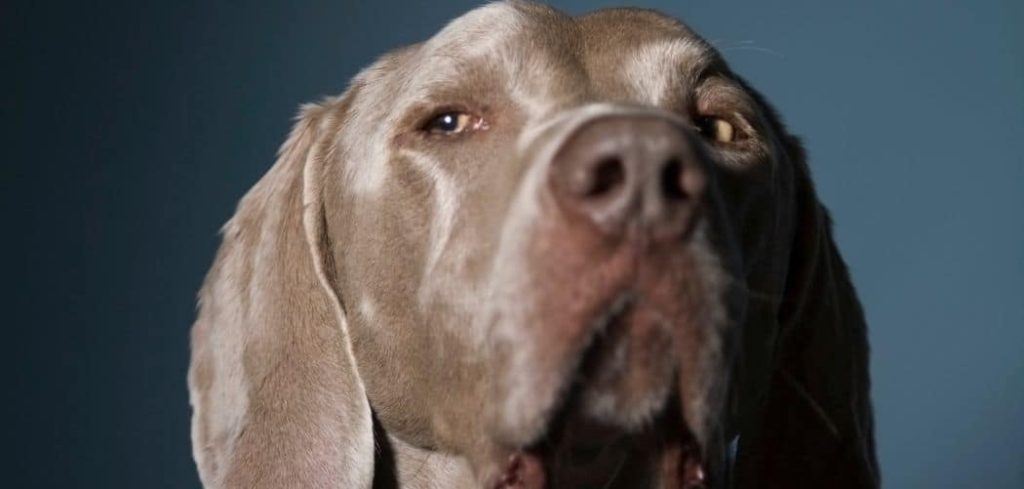Noticing your old dog’s face twitching can be worrying, especially if it happens often or suddenly.
Facial twitches may look mild at first but can signal anything from harmless muscle spasms to serious neurological conditions.
We outline the common causes of facial twitching in old dogs, what you can do at home, and when to seek veterinary help.
Old Dog Face Twitching — Why It Happens
Facial twitching in older dogs usually stems from muscle, nerve, or brain-related issues. It can be linked to seizures, electrolyte imbalances, dental pain, or even age-related neurological diseases.
Sometimes, it’s triggered by simple muscle fatigue, while in other cases it may be a sign of more serious conditions such as epilepsy or tumors.
The key is paying attention to frequency, duration, and whether other symptoms appear alongside the twitching.

Old Dog Face Twitching: Common Causes
Seizures
In senior dogs, seizures can sometimes appear as brief facial twitches rather than full-body convulsions. This can make them harder to spot, but they’re still a neurological event caused by abnormal brain activity.
You may notice your dog’s eyelid flickering, lip curling, or cheek muscles jerking involuntarily. These episodes may last seconds to minutes and can leave your dog disoriented afterward.
Seizures are always serious, especially in older dogs, as they can point to conditions like epilepsy, brain tumors, or metabolic disease.
Read more: Old Dog Face Changes (Explained)
Muscle Spasms
As dogs age, muscle weakness and fatigue can lead to localized spasms. These twitches are usually brief, mild, and may happen after exercise or long periods of holding tension in the jaw or face.
Unlike seizures, muscle spasms don’t typically cause confusion or collapse. Owners might see tiny, rhythmic jerks under the skin, especially around the eyes or jaw.
While often harmless, frequent muscle spasms could signal an underlying issue such as electrolyte imbalance or nerve irritation.
Dental Pain or Oral Problems
Tooth abscesses, gum infections, or jaw pain can cause facial twitching in old dogs. The irritation of inflamed nerves in the mouth can trigger spasms in nearby facial muscles.
Along with twitching, you may notice bad breath, difficulty chewing, pawing at the mouth, or drooling. Older dogs are especially prone to dental disease, which can be very painful and impact their overall health.
This cause is especially important to rule out, as untreated dental infections can spread and become life-threatening.
Neurological Disorders
Age-related neurological diseases such as canine cognitive dysfunction or degenerative brain disease may cause twitching. Nerve compression, injury, or inflammation can also affect the way signals are sent to facial muscles.
These twitches are often irregular and may occur alongside other neurological signs such as imbalance, confusion, or circling.
Neurological causes are more serious because they typically progress over time and require ongoing veterinary management.
Toxin Exposure
Some toxins, such as pesticides, certain plants, or medications, can affect nerve and muscle control, leading to tremors or twitching. In old dogs, a slower metabolism makes them more vulnerable to toxin buildup.
You might see other signs such as vomiting, drooling, tremors throughout the body, or unsteady walking.
This is an emergency situation, as toxin ingestion can rapidly become life-threatening if not treated quickly.
Pain or Stress
Sometimes, face twitching is a response to general discomfort, stress, or anxiety. Dogs may clench their jaws or tense their facial muscles, which can result in twitch-like movements.
While less dangerous than seizures or toxins, stress-induced twitching still signals that your dog isn’t fully comfortable. Older dogs may become more sensitive to changes in routine or environment, making stress-related symptoms more likely.
What to Do If Your Old Dog’s Face Is Twitching
If you notice twitching, first observe the pattern closely. Try to note when it happens, how long it lasts, and whether your dog seems otherwise normal or disoriented. Keeping a short video can help your vet see exactly what’s happening.
Make your dog comfortable by providing a calm, quiet space. Ensure they have access to fresh water and are not overheated or overly stressed.
Check their mouth for signs of dental pain if it’s safe to do so. Look for redness, swelling, or broken teeth. If your dog resists, don’t force it — leave that to your vet.
Avoid giving any human medications, as these can worsen symptoms. Instead, focus on keeping your dog calm and supported until you can seek veterinary care.
When to Call or Visit Your Vet
Facial twitching in an old dog should never be ignored, especially if it happens repeatedly. You should seek veterinary attention if twitching is accompanied by seizures, disorientation, difficulty walking, drooling, or collapse.
Even if the twitching seems mild, it’s worth discussing with your vet, as it may signal underlying neurological or dental disease.
Call your vet right away if the twitching is continuous, worsening, or linked to toxin exposure. If your dog suddenly develops widespread tremors or collapses, treat it as an emergency and head to a veterinary clinic immediately.
Read more: Old Dog Eyes Cloudy (Causes to watch for)
Key Takeaway
Old dog face twitching can be harmless at times but often signals an underlying health concern. From seizures and muscle spasms to dental disease and neurological disorders, there are many possible causes.
Pay close attention to the frequency and intensity of twitching, and always involve your vet in determining the cause. With timely care and monitoring, many older dogs can continue to live comfortably even with conditions that cause facial twitching.
